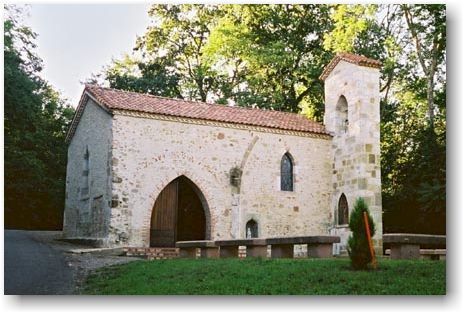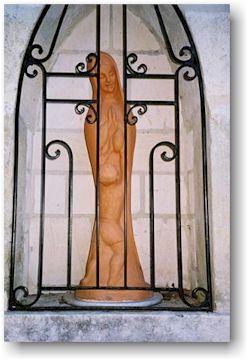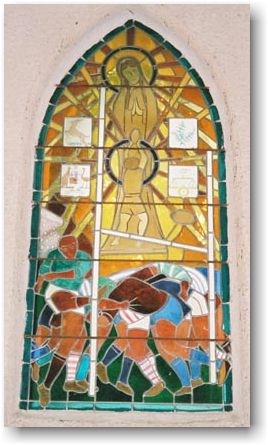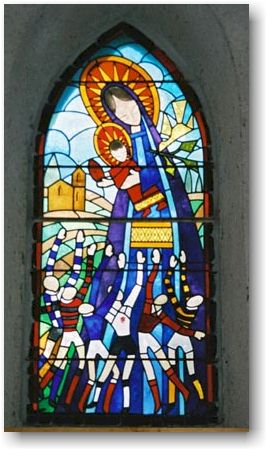I lifted this from John “Montana”
Thomas’ excellent proptalkrugby.com
site. He, in turn, lifted it from the Guardian Unlimited site. To see this
story with its related links on the Guardian Unlimited site, go to http://www.guardian.co.uk - Wes

On a Wing and a Prayer
In Southwest
France, rugby is religion - so much so that one priest has dedicated his chapel
to the sport.
Mark Whitaker went to find out what the
Virgin Mary is doing to secure the World Cup for the nation.
Mark Whitaker
Sunday October 26 2003
The Observer
 England, New Zealand and Australia had better beware: France has a secret
weapon in the Rugby World Cup. It is not a surprise tactic or a wonder-player
who has been kept under wraps. It is a force, for those who believe in her,
that is altogether more powerful than either of these - none other than the
Virgin Mary herself.
England, New Zealand and Australia had better beware: France has a secret
weapon in the Rugby World Cup. It is not a surprise tactic or a wonder-player
who has been kept under wraps. It is a force, for those who believe in her,
that is altogether more powerful than either of these - none other than the
Virgin Mary herself.
Rugby, the cliche goes, is a religion in the deep south-west of France; a
passion that has expressed and fuelled village and small-town rivalries in the
region for a century. Draw a line roughly from Bordeaux to Marseilles, and
another along the ridge of the Pyrenees from the Atlantic to the Mediterranean,
and you enclose the ancient provinces of Gascony and Languedoc and the parts of
France that are Basque and Catalan: and you define the boundaries of what many
call simply "l'Ovalie", the Land of the Oval Ball.
What the game once was in the valleys of south Wales or the Scottish borders
(and has never really been in England, however successful the national team
might be), it still is in south-west France. Go to a town-centre cafe and it
often soon becomes apparent that it is also the headquarters of the local team.
Or seek a hotel for the night in St Vincent de Tyrosse, half an hour's drive
north-east of Biarritz, and you will find that the only one in town is called
le Twickenham.
But nothing says more about this violent regional passion for rugby than a
small Romanesque chapel of yellow stone, with a red-tiled roof, that nestles in
a clearing on a wooded hillside above the village of Larriviere in the valley
of the Adour river. It is a little-known corner of France, on the eastern edge
of the great forests of the Landes and just to the south of Armagnac country.
If it is famous for anything, it is for its sweet Bayonne ham; but in recent
years it has also (to mix religions for a moment) become a Mecca for French
rugby players and fans. The chapel, which has obviously been recently and
painstakingly restored, has no sign outside, but at the bottom of the
single-track road from the village below a notice directs you to Notre Dame du
Rugby.
 Architecturally, the chapel has the usual austere simplicity of the Romanesque;
but there is nothing austere about its decoration. In glass cabinets around the
walls are hundreds of carefully folded rugby shirts of every imaginable colour.
The large majority are from French clubs, though a careful search reveals
garments from as far afield as Argentina, Tahiti and Cameroon. Some belonged to
French internationals: some have hand-written notes attached,
saying things such as: "In the hope that our noble sport may continue to
bring together men of the oval planet." And a Welshman who donated his
club shirt to the chapel obviously believes the Virgin has truly miraculous
powers. "In hopes of better results this year," his note reads.
Architecturally, the chapel has the usual austere simplicity of the Romanesque;
but there is nothing austere about its decoration. In glass cabinets around the
walls are hundreds of carefully folded rugby shirts of every imaginable colour.
The large majority are from French clubs, though a careful search reveals
garments from as far afield as Argentina, Tahiti and Cameroon. Some belonged to
French internationals: some have hand-written notes attached,
saying things such as: "In the hope that our noble sport may continue to
bring together men of the oval planet." And a Welshman who donated his
club shirt to the chapel obviously believes the Virgin has truly miraculous
powers. "In hopes of better results this year," his note reads.
Behind the altar there is a special cabinet with photos attached to the shirts
- a small shrine for local young men who have died on the pitch or as a result
of injuries inflicted during games. And it was a recognition of how dangerous
the game can be that led a local priest, Michel Devert, to restore the then
derelict chapel in the 1960s, and to dedicate it to the protection of his
favourite sport. Players from neighbouring teams put in the hard labour of
building the road, the bishop of nearby Dax weighed in with his support, elite
clubs from around the south-west played fund-raising fixtures in the area, and
donations poured in from across l'Ovalie.
For the consecration of the new chapel in June 1967, Devert wrote a special
prayer, which is framed next to the altar. This is a rough translation of its
first and last verses: "Virgin Mary, who taught your child Jesus to play
at your knee,/Keep a maternal watch over the game of these grown-up
children./Be with us also in the great scrum of existence,/So that we may come
out winners in the great game of life, /Giving an example - as on the field -
of courage, zest and team spirit,/In a word of an ideal in your name.
Amen."
Now an energetic 80 year old, living in retirement on the coast
between Biarritz and Bordeaux, Devert makes the 120-mile round trip to the
chapel at least once a week - to check that all is well, to restock the box of
postcards, and - he hopes - to find some visitors with whom he can talk rugby.
He is a fierce defender of the south-west's deep-rooted cultural identity - he
never ventures out without wearing his Basque beret, and the monthly mass he
celebrates at Notre Dame du Rugby is conducted in Gascon dialect. Ask him why
he has devoted so much of his life to the restoration of an out-of-the-way ruin
of a chapel, and he says simply: "Because I love rugby and I love the Virgin
Mary." He puts it in that order ... then quickly corrects himself.
 On the altar, there is an old-fashioned school exercise book in which visitors
to the chapel can jot down their thoughts and prayers. Judging from the
following entries, they obviously share Devert's sentiments. "Our Lady,
protect our new team." "Our Lady, cover with your compassion our son,
seriously injured in a match." "In memory of my grandfather, a rugby
player." "If rugby had existed in ancient times, Jesus would have
been a great player." And summing up the place, simply this: "Rugby
is a true religion."
On the altar, there is an old-fashioned school exercise book in which visitors
to the chapel can jot down their thoughts and prayers. Judging from the
following entries, they obviously share Devert's sentiments. "Our Lady,
protect our new team." "Our Lady, cover with your compassion our son,
seriously injured in a match." "In memory of my grandfather, a rugby
player." "If rugby had existed in ancient times, Jesus would have
been a great player." And summing up the place, simply this: "Rugby
is a true religion."
But the wonder of Notre Dame du Rugby are the chapel's four stained-glass
windows, not for their artistic merit, but for their content. In one, there is
a central figure of the Virgin, and at her feet is a scrum. A small boy (Jesus
as scrum half, perhaps) is offering Mary the ball. In another, the Virgin is
cradling an obviously injured player in her arms. And, in the most
dynamic of them all, Mary has the infant Jesus in her arms, while in his is a
rugby ball. At their feet, players are jumping as in a line-out; and Jesus (the
hooker this time) is clearly throwing in the ball. So forget about the Virgin
of the Rocks or the Virgin of the Pinks - at Larriviere there are the Virgins of
the Scrum and the Line-out.
The irony in all of this is that rugby's cultural conquest of south-west France
in the first two decades of the 20th century owed much to the Catholic church's
virulent opposition to the game. Jean Lacouture - the grand old man of French
radical letters and also rugby correspondent of Le Monde for many years - told
me recently that his Jesuit schoolmasters in Bordeaux during the 20s and 30s
refused to allow their pupils to play rugby. "They thought
there was something sinful, almost sexual about rugby - all those bodies
intertwined in the scrum was too much for them." Education had been at the
heart of the great cultural battle in France between church and state before
the first world war, and while church schools played soccer, secular ones
embraced rugby. And the traditionally republican, anti-clerical, communities of
the south-west took the oval ball to their hearts. So, belatedly, at least in
Larrivere, has the church.
The French are by no means favourites to win the World Cup. But their teams are
always capable of upsetting the form book. And if they do better than expected,
perhaps it is because, before jetting off to the antipodes, they made a private
pilgrimage to Notre Dame du Rugby.